Has anybody seen these? I saw sharpening supply had them and also that a company Preyda makes them. Apparently it is a ceramic waterstone made of novaculite as an abrasive. Looks pretty awesome. I am guessing somebody here has some experience with these.
-
The BladeForums.com 2024 Traditional Knife is available! Price is $250 ea (shipped within CONUS).
Order here: https://www.bladeforums.com/help/2024-traditional/
You are using an out of date browser. It may not display this or other websites correctly.
You should upgrade or use an alternative browser.
You should upgrade or use an alternative browser.
Arkansas waterstones?
- Thread starter cap'njake
- Start date
- Joined
- Mar 8, 2008
- Messages
- 26,145
I have no idea why that would be considered desirable. Silicon dioxide is only just barely harder than fully hardened steel. The rounded form of aluminum oxide particles is similar to that of silicon dioxide, but is much harder wearing.
Wowbagger
Gold Member
- Joined
- Sep 20, 2015
- Messages
- 8,036
Has anybody seen these? I saw sharpening supply had them and also that a company Preyda makes them. Apparently it is a ceramic waterstone made of novaculite as an abrasive. Looks pretty awesome. I am guessing somebody here has some experience with these.
The jury seems to be still out.
I don't do it.
Here is my experience with similar abrasive in a natural hard Arkansas stone; a very fine translucent. A fun stone if you have a lot of money and want something old timey, nostalgic and just right for plane high carbon steel.
All I was trying to do with this relatively brand new stone was debur the finished and polished edge you see in the photo. I was using a sharpening jig to hold the blade.
The steel is A2, tough but no big deal, it is a good modern alloy tool steel.
Notice how the steel literally polished the stone as FortyTwoBlades was saying. I couldn't get a photo to show the whole polished surface but I used most all the surface and it was polished.
I was able to condition the surface back to a good cutting stone using a diamond plate.
As I understand it if you use a coarse diamond plate to scratch up a natural stone then it can take of some significant metal and sharpen the alloy steels. I didn't go further with this I just went back to my man made water stones engineered to cut high alloy modern steels.
Upon inspecting the pores of this hard Ark stone using the hand held microscope shown I found no metal embedded in it easily found after sharpening plain carbon blades on the same stone.
This vid is by a guy I like and respect.
So that is some stuff to look at and think about.
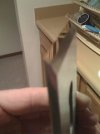
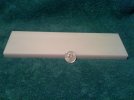

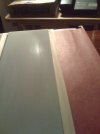
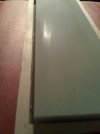
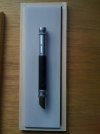
- Joined
- Mar 8, 2008
- Messages
- 26,145
The way I see it, one of the only things that Arkansas stones have as an advantage is that they're slow-cutting and (in the finer types) wicked hard. That makes it ok to use as an apexing stone on simple steels, but even pretty mundane stainless steels will render Arkansas stones marginally effective, and putting graded silicon dioxide in a water stone-style vitrified bond kind of ruins their high hardness advantage. Because the mechanical properties and abrasive shape of silicon dioxide isn't too different from being a downgraded version of aluminum oxide, it's sort of like making a cutoff wheel out of talc.
Now maybe I'm wrong, and it could provide uniquely positive properties in some limited contexts versus the same binder and grit/binder ratio with aluminum oxide, but I'd be very surprised.
Now maybe I'm wrong, and it could provide uniquely positive properties in some limited contexts versus the same binder and grit/binder ratio with aluminum oxide, but I'd be very surprised.
- Joined
- Nov 19, 2014
- Messages
- 2,633
- Joined
- Apr 12, 2009
- Messages
- 13,502
The way I see it, one of the only things that Arkansas stones have as an advantage is that they're slow-cutting and (in the finer types) wicked hard. That makes it ok to use as an apexing stone on simple steels, but even pretty mundane stainless steels will render Arkansas stones marginally effective, and putting graded silicon dioxide in a water stone-style vitrified bond kind of ruins their high hardness advantage. Because the mechanical properties and abrasive shape of silicon dioxide isn't too different from being a downgraded version of aluminum oxide, it's sort of like making a cutoff wheel out of talc.
Now maybe I'm wrong, and it could provide uniquely positive properties in some limited contexts versus the same binder and grit/binder ratio with aluminum oxide, but I'd be very surprised.
That's my impression as well. Ark stones of any kind are limited from the get-go, in terms of what steels they'll work with. There's a pretty abrupt threshold between working very well, and not working at all, with Arkansas stones and the steels one attempts to sharpen on them. It's a very pleasant & satisfying experience in finding some simpler steel blades that respond well on them, like 1095, CV or 420HC. But otherwise, it'll be a very frustrating experience for those steels not responding to them, either in overpolishing/burnishing issues, or just heavy burring of the edges, because the abrasive isn't up to the task of actually cutting many modern and higher-alloyed steels.
David
